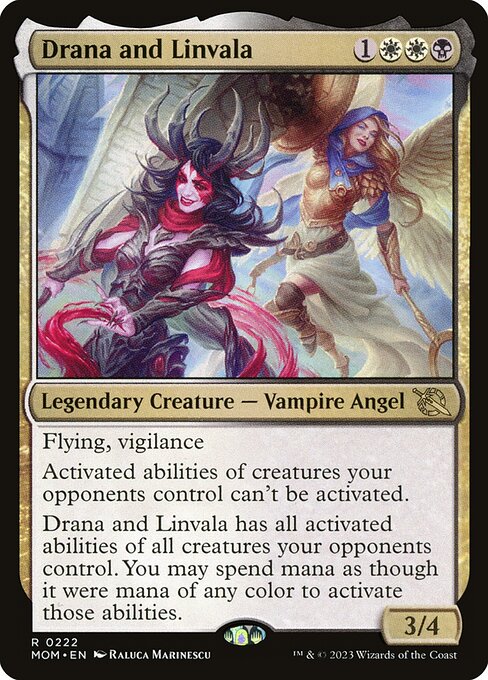
Image courtesy of Scryfall.com
Empathy-Driven Design for Diverse MTG Playstyles
Magic: The Gathering thrives on variety—deckbuilders who adore a serialized control plan, players who chase explosive midrange combos, and budget-conscious duelists who squeeze value from small slips of color. In that spirit, Drana and Linvala stands out not just as a card with potent gameplay, but as a case study in empathy-forward design. Its color identity of black and white (B/W) nods to the classic tension between restraint and reach, order and ambition 🧙♂️🔥. The card’s presence in March of the Machine borrows from a broader storyline where two iconic archetypes—vampiric finesse and celestial order—collide and collaborate, creating a narrative space where diverse playstyles can coexist at the table.
At its heart, Drana and Linvala is a rare Legendary Creature — Vampire Angel with a burden and a boon: it can shut down activated abilities on your opponents’ boards while simultaneously becoming a conduit for those very abilities. The blend of Flying and Vigilance ensures you’re not simply defending; you’re setting the pace of the battlefield, whether you’re gliding over blockers or pressing in while opponents stumble for answers 🛡️⚡. The card’s core mechanic—“Activated abilities of creatures your opponents control can't be activated”—reads as a diplomatic gesture: it slows others down, giving you space to maneuver without piling on the inevitability of a straight fatigue grind.
Flying, vigilance. Activated abilities of creatures your opponents control can't be activated. Drana and Linvala has all activated abilities of all creatures your opponents control. You may spend mana as though it were mana of any color to activate those abilities.
And yet the real empathy emerges in the secondary ability: you may use your mana to activate those abilities in your opponents’ boards. This is not about stealing them wholesale; it’s about offering a shared playground where a skilled pilot can leverage the same toolkit their rival has access to, but with careful timing and open information. It’s a design decision that rewards thoughtful interaction—biting into a threat, siphoning a key effect, or baiting an overextension—without turning the table into a one-sided grind. That’s the kind of design nuance that resonates with players who love different shells, from prison-style stopgaps to tempo-driven shenanigans 🧪⚔️.
Design empathy in action: five takeaways for diverse playstyles
- Access over domination: Drana and Linvala offers power with restraint. By blocking activated abilities while sharing access to those same abilities, the card invites both control players and combo enthusiasts to dance around each other’s tools rather than trampling one another.
- Color identity as a narrative tool: The black-and-white identity mirrors classic MTG tension—death and judgment against order and restoration. This balance encourages decks that mix removal and defense with resilient board presence, appealing to both aggro-neutral and prison-minded players 🩸⚖️.
- Tempo through synergy: The vigilance trait keeps you ahead on offense, turning every attack into a measured tempo play rather than a reckless sprint. It’s a nod to players who prize planning and resource management as much as raw power ⌚💎.
- Politics as a feature, not a tax: In formats like Commander, the card’s abilities create opportunities for diplomacy and bluffing. Opponents might trade threats or strike bargains, knowing that your toolkit includes their own options—just with a twist of timing and color-matching intuition 🧭🎭.
- Design for accessibility: The mana requirements and the textual clarity make the card accessible to players who are building toward a blended color strategy. It rewards thoughtful coloring and mana fixing without demanding an overcomplicated mana base.
From a gameplay perspective, Drana and Linvala also invites creative deck-building experiments. Imagine a black-white blink or flicker shell that uses opponent-triggered abilities as a resource, or a prison deck that hedges against marshalling disruptions while your own threats are carefully sequenced. The card’s Rarity (Rare) and its presence in a modern set like MOM also give it a distinct collectible appeal—foil versions can sparkle in a mana-dense board, while nonfoil prints remain accessible for kitchen-table champions. And yes, the lore flavor—two powerful figures merging in a time of machine-driven conflict—lends itself to flavorful storytelling during casual play or tournament commentary 🏰🎨.
If you’re sipping coffee and drafting a new list, consider how a card like Drana and Linvala reframes "play your best" moment—from simply casting cheap value to designing an interaction where you shape outcomes by inviting opponents to participate in their own tricks with you in the driver’s seat. It’s a reminder that MTG isn’t just about who has the biggest creature or the flashiest combo; it’s about shaping a shared narrative where diverse playstyles are welcomed and challenged in equal measure 🧙♂️💬.
To keep you sharp during those long table sessions, a comfortable desk setup matters—the ergonomic memory foam wrist rest mouse pad helps you maintain focus without the cramping or fatigue that can derail even the sharpest reads. It’s a small investment in the day-to-day joy of MTG research, testing, and table talk. If you’re curious, you can check it out here: Ergonomic Memory Foam Wrist Rest Mouse Pad 🧎♂️🎲
As you explore Drana and Linvala in your next game night, remember that the best MTG cards aren’t just engines of power—they’re catalysts for community, conversation, and shared strategy. The moment when you tactically disable an opponent’s trick, while secretly enabling your own access to the same trick, is the moment design and playstyle empathy align in a perfect, mana-neutral harmony ⚡💎.
More from our network
- https://blog.rusty-articles.xyz/blog/post/explores-delcatty-price-volatility-across-releases/
- https://blog.digital-vault.xyz/blog/post/sedraxis-specter-data-visualization-mtg-card-attribute-breakdown/
- https://transparent-paper.shop/blog/post/ai-image-generation-in-advertising-transforms-visual-campaigns/
- https://crypto-acolytes.xyz/blog/post/how-tokenomics-shapes-day-trading-strategies/
- https://blog.crypto-articles.xyz/blog/post/why-ring-cameras-are-sharing-more-with-law-enforcement-today/